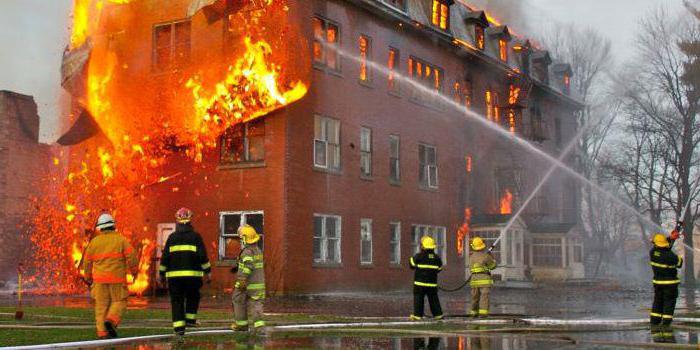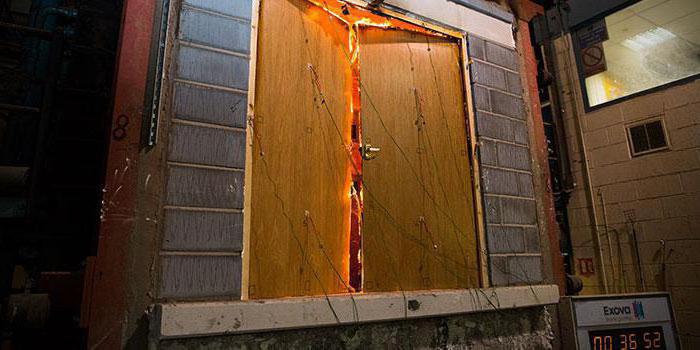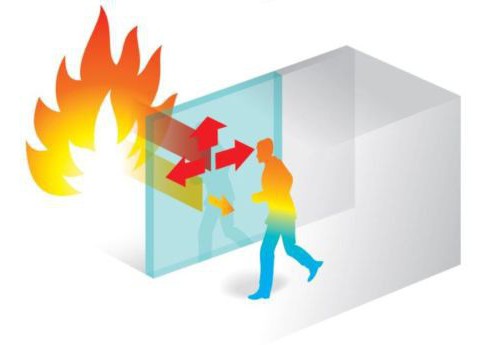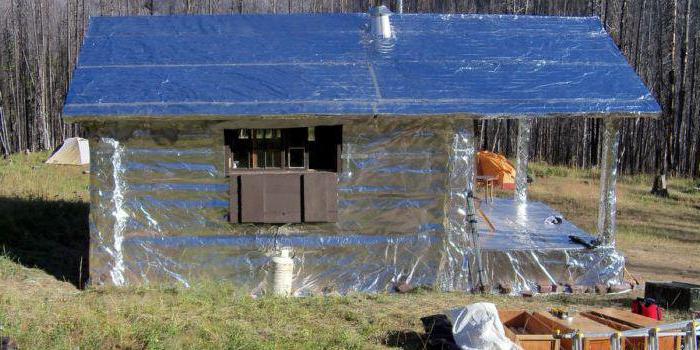The indicator that determines the level of protection of buildings and structures from the effects of fire is called the degree of fire resistance. The degree of resistance to fire and combustion products depends on the boundary values of fire resistance of the structures and materials from which the building was erected. When determining the fire safety of a building, the size of the building, its location and the temperature limit of ignition of materials are taken into account.
 By definition, the fire resistance of a building object is its ability to perform operational functions for some time with continuous fire exposure. Fire resistance implies the complete preservation of the bearing and restraining capabilities of the structure (walls or roofs will not collapse under the influence of fire, create a barrier to combustion products, fire).
By definition, the fire resistance of a building object is its ability to perform operational functions for some time with continuous fire exposure. Fire resistance implies the complete preservation of the bearing and restraining capabilities of the structure (walls or roofs will not collapse under the influence of fire, create a barrier to combustion products, fire).
Fire resistance limits of building elements
The resistance of a building or structure to the effects of fire is determined by the length of time that fixes the beginning of the test and the moment of the appearance of a sign of destruction:
- the appearance of through holes in the test sample (burnouts, cracks), facilitating fire penetration and gas penetration;
- excess of the average temperature at the measuring points of the unheated part of the structure by 160 ° C or exceeding 190 ° C at one of the measuring points of the unheated surface (the indicators do not take into account the initial surface temperature);
- loss of bearing ability, collapse or deformation of individual elements.
General parameters of the fire resistance of the building
The overall ability of a building to withstand destruction by fire is determined by the degree of fire resistance. Regulatory documents define 8 degrees of fire resistance of a building. A decrease in the fire resistance limit occurs as the number of its category increases. The fire resistance of a building or structure is determined based on the fire resistance of the elements of the structure, the speed of flame propagation, as well as the temperature limit of ignition of the used building materials.
Fire rating of industrial facilities
Determining the ability of an industrial building to block or limit the spread of fire, add a level to the general parameters fire hazard housed in a production building. The number of storeys of the structure and the area of each site are taken into account.
The fire resistance limits of a structure are characterized by a group of time-normalized limit states of loss of bearing abilities, structural integrity, and heat insulation abilities.
According to the degree of ignition of the building material, the building is divided into the following groups:
- non-combustible - buildings erected from materials that are not able to burn or char;
- slow-burning - the building material is capable of ignition exclusively under the continuous action of fire, for example, a tree protected from fire by special impregnations;
- combustible - the building material supports self-combustion after removal of the source of ignition.
 The fire resistance indicators of all elements of the building are calculated: the fire resistance of doors, window blocks, hatches and partitions. Proper attention shall be paid to the extent of structural damage during fire propagation tests. The exact parameters of damage to the contraction beyond the direct fire zone are calculated.
The fire resistance indicators of all elements of the building are calculated: the fire resistance of doors, window blocks, hatches and partitions. Proper attention shall be paid to the extent of structural damage during fire propagation tests. The exact parameters of damage to the contraction beyond the direct fire zone are calculated.
Classification and features of the construction of fences
Objects with normalized fire resistance limits can prevent the spread of open fire and its products of combustion in adjacent rooms that do not contain a source of ignition. Fire barriers can be enclosing structures erected from non-combustible materials, water curtains, ceilings, special tanks that prevent the spread of fire.
Barrier classification
Barriers blocking fire and combustion products are divided into classes depending on the method of protection:
- fire-resistant vertical supporting walling;
- enclosing floors;
- spaces blocking the spread of fire and gaps in the joints of building structures;
- blocking vestibules;
- fire screens;
- water curtains blocking the spread of fire;
- strips protecting from movement of fire.
 Building envelopes, depending on the limit values of fire resistance and types of structural elements, have the following gradation:
Building envelopes, depending on the limit values of fire resistance and types of structural elements, have the following gradation:
| № | Fire barriers | Regulatory Types |
| 1 | vertical supporting structures | 1, 2 |
| 2 | horizontal walling | 1, 2, 3, 4 |
| 3 | vestibules | 1, 2 |
| 4 | water curtains | 1 |
| 5 | enclosing screens, hatches, gates and window blocks | 1, 2, 3 |
Feature of the construction of fire barriers
Walls of fire-resistant materials are erected to the height of the rooms. Fire resistance limits of enclosing walls and partitions fire compartment must comply with the fire resistance of mating barriers. The purpose of using fire walls is to block the penetration of fire into adjacent rooms, even if the building is unilaterally collapsed.
Fire barriers preclude the installation of opening window units. Mechanisms that involve operation in the open position (doors, valves, hatches, etc.) are equipped with automatic emergency closing and locking mechanisms that activate when a fire occurs.
 The total area of the openings of fire-resistant barriers cannot be more than 25% of the total area of the room. Fire barriers separating explosive and fire hazardous and explosive rooms (compartments) from other rooms equip a vestibule with a continuous air supply system.
The total area of the openings of fire-resistant barriers cannot be more than 25% of the total area of the room. Fire barriers separating explosive and fire hazardous and explosive rooms (compartments) from other rooms equip a vestibule with a continuous air supply system.
How to determine the resistance of a barrier to fire?
Determination of the fire resistance of a building is made taking into account the values of all the elements of which it consists:
- structural elements of the fence;
- fastening mechanisms;
- supporting structures.
Standards table:
| The name of the fence | Sustainability | Fencing type | Type of
vestibule |
| vertical supporting structures | 150 (rei) | 1 | 1 |
| 45 (rei) | 2 | 2 | |
| horizontal internal protective structures | 150 (rei) | 1 | 1 |
| 60 (rei) | 2 | 1 | |
| 45 (rei) | 3 | 1 | |
| 15 (rei) | 4 | 2 | |
| dividing vertical structures | 45 (ei) | 1 | 1 |
| 15 (ei) | 2 | 2 | |
| dividing vertical structures containing glazing with an area of 25% | 45 (eiw) | 1 | 1 |
| 15 (eiw) | 2 | 2 |
The fire resistance limit rei is the time before the onset of the state of loss of bearing capacity, structural integrity and thermal insulation.
Fire resistance limit ei is the time limit before destruction and loss of heat-insulating ability.
Fire resistance limit eiw - the boundary time limit for the loss of structural integrity, thermal insulation or loss of ability to retain heat under the influence of 3.5 kW / m2 on the heat flux plane.
Fire rating of structures
Each building or structure consists of structural elements. The structural elements perform certain functions and have individual characteristics of resistance to fire. The fire resistance of building structures and individual elements is different. Under the general fire resistance of a structure is meant the ability of an object to avoid destruction, while maintaining the ability to enclose fire and combustion products.
 Buildings are divided into types according to their purpose.In addition, each type of structure must comply with the fire-retardant quality characteristics defined for it in regulatory documents. The classification of building structures by the value of fire resistance and the requirements for structural elements is set forth in special reference codes-building codes of SNiP.
Buildings are divided into types according to their purpose.In addition, each type of structure must comply with the fire-retardant quality characteristics defined for it in regulatory documents. The classification of building structures by the value of fire resistance and the requirements for structural elements is set forth in special reference codes-building codes of SNiP.
Rules and norms of fire protection of buildings - SNiP
SNiP - a document containing a list of regulatory acts, technical, economic and other requirements in relation to construction work. SNiP can be adjusted and supplemented by regulatory documents. For example, the rules and fire safety standards dated 01/21/1997 supplemented by technical regulations on the fire safety requirements for roof fencing dated July 28, 2008 No. 123-ФЗ.
SNiP from 01.21.97, regulates construction work in relation to fire safety at the stages of construction and operation of buildings of various types. The main attention is paid to self-supporting structures, the fire resistance of the walls is indicated depending on the type of construction and the characteristics of the operation of the structure.
 The fire safety regulation contains 5 levels of fire resistance. Also indicated are the parameters that the constructed structure must comply with:
The fire safety regulation contains 5 levels of fire resistance. Also indicated are the parameters that the constructed structure must comply with:
- maximum load carried by the building structure - (R);
- maintaining structural integrity in case of fire - (E);
- ability to isolate heat - (I).
The degree of resistance of building structures to fire is calculated taking into account the loss of these indicators.
Continuing consideration of the issue of fire resistance of buildings, it is necessary to take into account the division of the ability of buildings to resist the fire into two types: required and actual fire resistance.
Required is the minimum resistance value that any building must meet in relation to fire safety. The degree of fire resistance of the structure is calculated empirically (in contrast to the actual degree determined by the calculations).
The actual indicator of fire resistance is the value obtained as a result of the calculation performed at the project creation stage. Actual fire resistance is determined by experts of expert services.
Fire resistance of materials of buildings and structures
Building materials are divided into different groups. In each of them, building materials are classified according to their degree of resistance to fire and combustion products. The general indicator of building resistance to fire is calculated and completely depends on the indicators of materials used in its construction. The building codes indicate the gradation of materials in two groups - a group of combustible and non-combustible materials.
 With regard to the type of combustible building materials, there is an additional gradation set forth in GOST 30244:
With regard to the type of combustible building materials, there is an additional gradation set forth in GOST 30244:
- highly flammable - include rolled polymer flooring, temperature less than 300 ° C;
- normally flammable - materials whose combustion maintaining temperature is more than 300 ° C;
- moderately flammable - any kind of polymer building materials is excluded;
- low combustibility - materials are used mainly in the construction of shopping malls, technological rooms, stairwells and vestibules (example: porcelain stoneware and ceramic tiles).
All measures to determine the degree of fire resistance of buildings are aimed at ensuring the safety of people during the operation of buildings. Neglect of fire safety in construction threatens human health and life.
How to independently determine the fire resistance of building structures?
Fire tests are often used to calculate fire resistance limits. In order to independently calculate the time of resistance to fire, it is necessary to have a construction project on hand, then follow the instructions.
Instruction: procedure for determining the fire resistance limit
- During the development of project documentation, experts indicate the estimated fire resistance of the building. You should independently compare the structure of the building with the building codes reflected in SNiP.
- The limit of fire resistance is considered to be the time elapsed from the start of the fire on the construction contract until the moment of manifestation of critical changes in its condition (destruction, deformation or loss of integrity).
- The general indicator of fire resistance is determined by the limit values of resistance to fire and combustion products of the key building structures of the building. The fire resistance limit is taken into account: partitions, vertical supporting structures, doors, window blocks, etc. Data that reflect the ignition level of used building materials must be entered into the calculation. Analyze the building design in detail.
- Information about the main building elements is not enough for an objective calculation of the fire resistance of a building. It is necessary to take into account the indicators of all elements, including flights of stairs, partitions, hatches, window blocks, etc.
- In order to study in detail the mechanism and rules for calculating the fire resistance limits, attention should be paid to benefits for SNiP.










